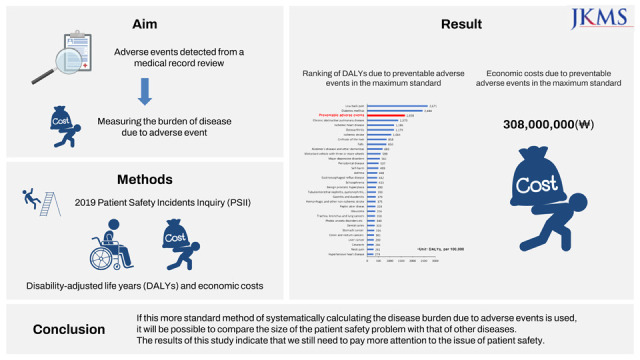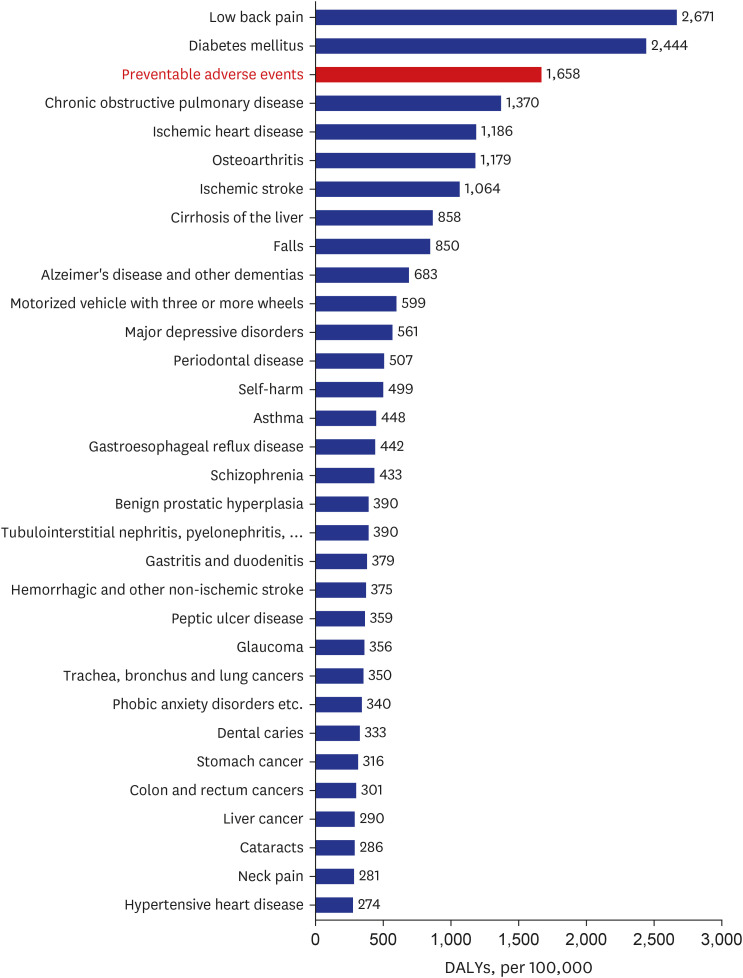1. Kohn LT, Corrigan JM, Donaldson MS. To Err Is Human: Building a Safer Health System. Washington, D.C., USA: National Academies Press;1999.
2. Pronovost PJ, Goeschel CA, Marsteller JA, Sexton JB, Pham JC, Berenholtz SM. Framework for patient safety research and improvement. Circulation. 2009; 119(2):330–337. PMID:
19153284.

5. Liang C, Miao Q, Kang H, Vogelsmeier A, Hilmas T, Wang J, et al. Leveraging patient safety research: efforts made fifteen years since to err is human. Stud Health Technol Inform. 2019; 264:983–987. PMID:
31438071.
6. Borzecki AM, Rosen AK. Is there a ‘best measure’ of patient safety? BMJ Qual Saf. 2020; 29(3):185–188.

7. Nauman J, Soteriades ES, Hashim MJ, Govender R, Al Darmaki RS, Al Falasi RJ, et al. Global incidence and mortality trends due to adverse effects of medical treatment, 1990–2017: a systematic analysis from the global burden of diseases, injuries and risk factors study. Cureus. 2020; 12(3):e7265. PMID:
32195071.

8. McDonald SA, Nijsten D, Bollaerts K, Bauwens J, Praet N, van der Sande M, et al. Methodology for computing the burden of disease of adverse events following immunization. Pharmacoepidemiol Drug Saf. 2018; 27(7):724–730. PMID:
29575242.

9. Kim YE, Jung YS, Ock M, Yoon SJ. DALY estimation approaches: understanding and using the incidence-based approach and the prevalence-based approach. J Prev Med Public Health. 2022; 55(1):10–18. PMID:
35135044.

10. Kim YE, Jung YS, Ock M, Yoon SJ. A review of the types and characteristics of healthy life expectancy and methodological issues. J Prev Med Public Health. 2022; 55(1):1–9. PMID:
35135043.

11. Jo C. Cost-of-illness studies: concepts, scopes, and methods. Clin Mol Hepatol. 2014; 20(4):327–337. PMID:
25548737.

12. Brown P, McArthur C, Newby L, Lay-Yee R, Davis P, Briant R. Cost of medical injury in New Zealand: a retrospective cohort study. J Health Serv Res Policy. 2002; 7(Suppl 1):S29–S34. PMID:
12175432.

13. Hoogervorst-Schilp J, Langelaan M, Spreeuwenberg P, de Bruijne MC, Wagner C. Excess length of stay and economic consequences of adverse events in Dutch hospital patients. BMC Health Serv Res. 2015; 15(1):531. PMID:
26626729.

14. Kjellberg J, Wolf RT, Kruse M, Rasmussen SR, Vestergaard J, Nielsen KJ, et al. Costs associated with adverse events among acute patients. BMC Health Serv Res. 2017; 17(1):651. PMID:
28903748.

15. Adler L, Yi D, Li M, McBroom B, Hauck L, Sammer C, et al. Impact of inpatient harms on hospital finances and patient clinical outcomes. J Patient Saf. 2018; 14(2):67–73. PMID:
25803176.

16. Khan MA, Soteriades ES, King J, Govender R, Hashim MJ, Masood-Husain S, et al. Global trends and forecast of the burden of adverse effects of medical treatment: epidemiological analysis based on the global burden of disease study. Cureus. 2020; 12(3):e7250. PMID:
32195068.

17. Kim MJ, Seo HJ, Koo HM, Ock M, Hwang JI, Lee SI. The Korea National Patient Safety incidents inquiry survey: characteristics of adverse events identified through medical records review in regional public hospitals. J Patient Saf. 2022; 18(5):382–388. PMID:
35948288.

18. Kim MJ, Seo HJ, Koo HM, Ock M, Hwang JI, Lee SI. The Korea National Patient Safety incidents inquiry survey: feasibility of medical record review for detecting adverse events in regional public hospitals. J Patient Saf. 2022; 18(5):389–395. PMID:
35067623.

19. Ock M, Lee JY, Oh IH, Park H, Yoon SJ, Jo MW. Disability weights measurement for 228 causes of disease in the Korean Burden of Disease Study 2012. J Korean Med Sci. 2016; 31(Suppl 2):Suppl 2. S129–S138. PMID:
27775250.

20. Kim YE, Park H, Jo MW, Oh IH, Go DS, Jung J, et al. Trends and patterns of burden of disease and injuries in Korea using disability-adjusted life years. J Korean Med Sci. 2019; 34(Suppl 1):e75. PMID:
30923488.

24. Klein DO, Rennenberg RJ, Koopmans RP, Prins MH. A systematic review of methods for medical record analysis to detect adverse events in hospitalized patients. J Patient Saf. 2021; 17(8):e1234–e1240. PMID:
32168280.

25. Lee YR, Cho B, Jo MW, Ock M, Lee D, Lee D, et al. Measuring the economic burden of disease and injury in Korea, 2015. J Korean Med Sci. 2019; 34(Suppl 1):e80. PMID:
30923489.

26. Ock M, Park B, Park H, Oh IH, Yoon SJ, Cho B, et al. Disability weights measurement for 289 causes of disease considering disease severity in Korea. J Korean Med Sci. 2019; 34(Suppl 1):e60. PMID:
30923484.








 PDF
PDF Citation
Citation Print
Print






 XML Download
XML Download